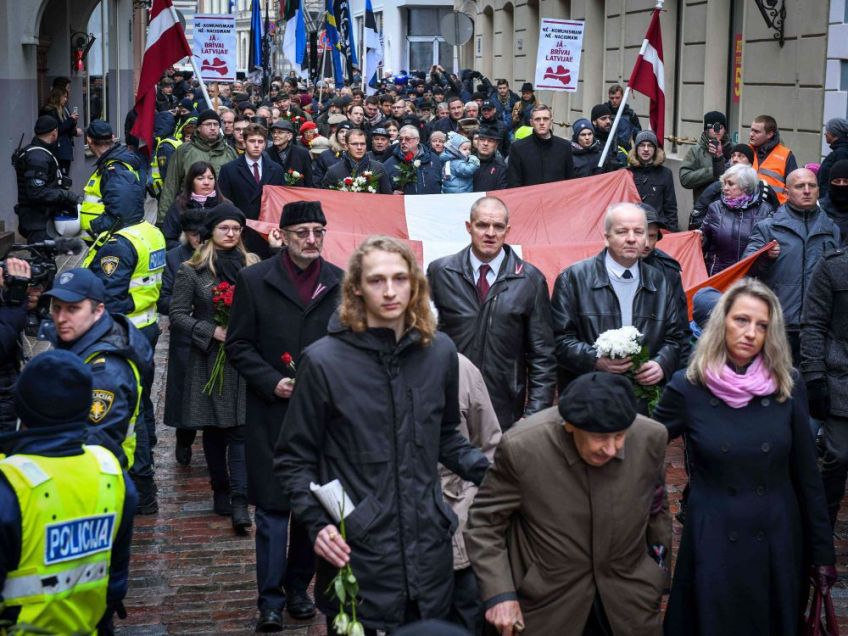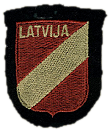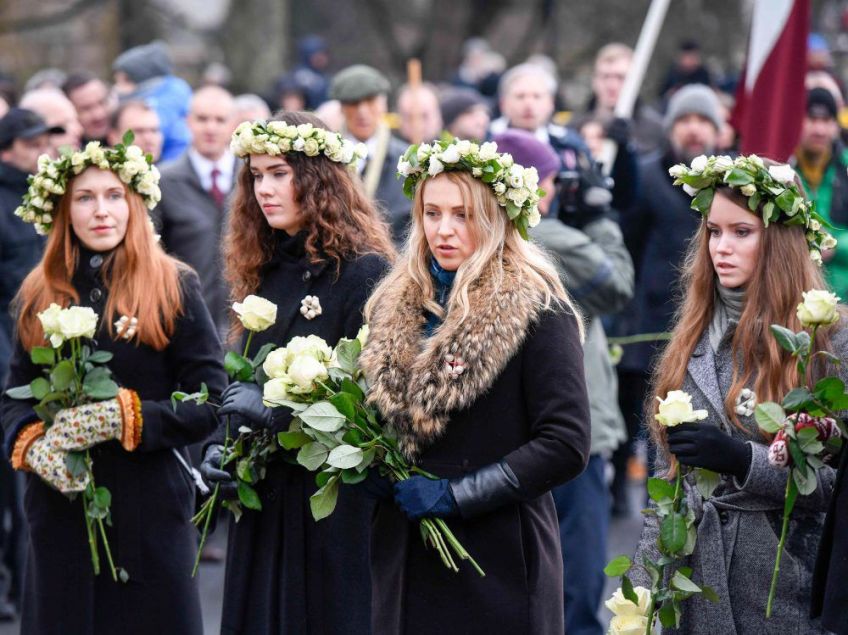Amy Mills, a spokeswoman for Global Affairs Canada — 20 March 2019 "Canada is strongly opposed to the glorification of Nazism and all forms of racism, racial discrimination, xenophobia, intolerance and extremism," Mills said. "That is why we condemn the parade to commemorate the Latvian SS Brigade held in Latvia on March 16th."
Lowenberg provides a link to an article which originated at the Ottawa Citizen, retrieved and reproduced here for commentary.
Canada condemns annual Latvian parade that honours Nazi SS unit
Around 1,000 people marched in Riga on March 16 in honour of the Latvian SS divisions which fought for the Nazis in the Second World War
David Pugliese, March 20, 2019

The Canadian government has added its voice to those condemning an annual parade in Latvia’s capital 1honouring members of the Nazi SS, saying it opposes any such event glorifying Adolf Hitler’s regime.
Around 1,000 people marched in the parade in Riga on March 16 in honour of the 2Latvian SS divisions which fought for the Nazis in the Second World War. Some in the parade wore swastikas and other Nazi insignias.
The 3parade has been controversial for decades. The United Nations, European Parliament and various politicians have raised concerns about the event, and Jewish groups have called on Latvia to put a halt to the gathering.
Amy Mills, a spokeswoman for Global Affairs Canada, said the Canadian government seeks to promote tolerance and respect for human rights. “Canada is strongly opposed to the 4glorification of Nazism and all forms of racism, racial discrimination, xenophobia, intolerance and extremism,” Mills said. “That is why we condemn the parade to commemorate the Latvian SS Brigade held in Latvia on March 16th.”
“We do not tolerate antisemitism of any form, at any time, or in any place and are deeply concerned about new and resurgent forms of antisemitism and discrimination worldwide, rooted in a misguided belief that diversity is a threat,” she added.
The Canadian Forces has 540 soldiers in Latvia and leads a NATO battlegroup there. They have been in Latvia since mid-2017 and the Liberal government says they will remain there until 2023. Mills said Canada’s close relationship with the country includes discussions on the development of an “inclusive Latvia.”
“5Every country must come to grips with difficult periods in its past,” she added.
Hitler ordered the creation of the Latvian SS divisions in 1943, with 6the initial core of the force made up of members of Latvian units such as the Arajs Kommando, which participated in the murder of 26,000 Jews. Other Latvians were conscripted to join the force.
Some 7members of the Latvian SS Division were among the last hold-outs of Hitler’s regime, defending parts of Berlin during the final days of fighting in the Second World War.
The Latvian government has defended the parade, saying that “16 March is not an official remembrance day, and people, on their own private initiative, pay their respects to the fallen soldiers.”
The Latvian government also has on its website 8a 14-page document that argues Russian “disinformation” is behind efforts to paint the gathering in an unfavourable light.
“The Latvian Legion as a military formation has no relation to the Holocaust or war crimes,” the document from Latvian historians noted.
The document did, however, 9acknowledge that some members who served in the Latvian SS units were tried after the war for their participation in the Holocaust but suggests those killings of innocent people were done before they joined the SS formation.
The Embassy of Latvia in Canada has also pushed back against criticism of members of the Latvian SS units and the annual parade. It recently labelled a Ottawa Citizen commentary describing the participation of Latvians in the SS division and the Holocaust as a “threat to democracy in the world.”
“One must study history in order to understand the truth,” the embassy added in a tweet.
The Latvian historians state 80 to 85 per cent of those Latvians who served in the SS division were conscripted and had strong anti-German sentiments. Many Latvians see those who fought in the SS unit as heroes since they battled the Soviets. The Soviet Union, at the time, was allied with the U.S., Britain, Canada and other nations who formed an alliance to defeat Nazi Germany and the nations that supported Hitler.
B’nai Brith Canada has also raised concerns about the parade and other events in Latvia. In the summer of 2018 B’nai Brith Canada’s chief executive officer Michael Mostyn called on Prime Minister Justin Trudeau to use his trip to Latvia that year to 10push back against that country’s glorification of Nazi collaborators as well as attempts to deny the nation’s role in the Holocaust. “We must challenge all those who distort the historical record on governments, military units or organizations that fought with, supported or sympathized with the Nazis during World War II,” Mostyn wrote to Trudeau. “This includes government leaders who acquiesce in, or fail to condemn, a process of Nazi glorification that amounts to Holocaust distortion.”
In 2014 the Israeli government raised concerns about a musical being performed in Latvia that celebrated the life of Nazi war criminal Herbert Cukurs. Cukurs was a key member in the Arajs Kommando and was known as the “Butcher of Riga.” 11A number of Holocaust survivors have directly linked Cukurs to the murder of Jews. Cukurs is a national hero in Latvia.
Concerns have also been raised about 12similar events in other nations. In late April 2018 more than 50 members of the U.S. Congress condemned Ukraine’s ongoing efforts to glorify those Ukrainians who collaborated with the Nazis. The letter, signed by both Republicans and Democrats, outlined concerns about ongoing ceremonies to glorify leaders of the Ukrainian Insurgent Army as well as 14th SS Galizien Division.
In 2018 the Trudeau government removed a number of Russian diplomats from Canada, citing their efforts that outed Foreign Affairs Minister Chrystia Freeland’s Ukrainian-born grandfather, Michael Chomiak, as a Nazi collaborator. Trudeau said the Russians were “sharing scurrilous stories” about Freeland on social media.
Chomiak edited a newspaper for the Nazis which included anti-Semitic essays and cartoons as well as articles highlighting the need for Ukrainians to join the SS. The Los Angeles Museum of the Holocaust, which has copies of Chomiak’s publication in its archives, describes it as a “collaborator” newspaper.
Email: dpugliese@postmedia.com | Twitter: davidpugliese
Examination
Pugliese's piece is the first somewhat balanced approach to the topic of the Latvian Legion and its commemoration. Nevertheless, it paints Latvians as allied with Nazis, and makes categorically false statements regarding the composition of the Legion.
The crux of the issue presents itself at the outset. The Latvian Legion were not members of the German "Nazi SS." Members of the "Nazi SS" are not being honored. The commemoration of the Legion has absolutely nothing to do with Adolf Hitler's regime, a brutal, murderous, occupying power loathed by Latvians.
There was no "Latvian SS". The Latvian Waffen grenadier (infantry) divisions "of the SS" (that is, a possession of the SS, not the SS proper) were created, from the Nazi perspective, to augment combat strength on the Eastern Front. For the Latvians, whether conscripted or earlier Eastern Front volunteers (these were not Holocaust collaborators) incorporated into the Legion, their only goal (as Germans officers complained) was to prevent the return of the Red Army and Soviet occupation. No one fought "for" the Nazis.
This is patently false. Latvians have commemorated the Legion since 1952 — now seventy-two years. Commemoration was never a controversy until Latvia declared a national holiday commemorating all Latvians who fell in combat in WWII, provoking Russian ire and a concerted propaganda campaign painting Latvians as Nazis.
Mills falsely lumps the Latvian Legion with Hitler's Nazi German SS.
Latvia has long since acknowledged the actions of Latvian collaborators in the Holocaust. (I would note that Viktors Arājs, the most notorious of "Latvian" collaborators, hailed from a wealthy Baltic German family on his mother's side. Baltic German culture generally looked down on Latvians as their inferiors.) Latvia, the country, dedicated its merchant marine to the Allied cause in its only official action.
This is categorically false.
Once the Nazi Holocaust had swept through Latvia, Arājs's unit remained intact, increased in numbers, and deployed westward to take part in anti-partisan and anti-Jewish actions in areas including today's Belarus.
The Germans assembled the Legion from battalions which had been serving on the Eastern Front since the start of the Nazi occupation. These were volunteers who signed up to insure the Red Army would leave and never return. These battalions were combat units subordinated to the Wehrmacht had no role in the Holocaust. Thus, the core of the Legion was blameless in the Holocaust, and not formed from the most notorious collaborators in Latvian history.
Members of Arājs's unit — despised by the Legionnaires — were redeployed into the Legion late in the war as conditions on the Eastern Front deteriorated. None of the crimes they were guilty of took place while they were ostensibly in the Legion. The Nazis gave Arājs command of a Legion unit, then immediately stripped him of command as unfit and sent him for training to Germany. (Arājs's own men described him not as any sort of commander, but as the guy who brought the booze to the slaughter during the Holocaust.)
Aside from the, again, incorrect description as an "SS Division," Latvian war diaries describe the brutal combat overlooking the garden where Hitler once took his German Shepherd Blondi for walks. This had nothing to do with being among the last "Nazi" hold-outs, just as the Legion in Courland were not "Nazi" hold-outs. At the close of the war, it was simply a struggle for survival against overwhelming Russian forces. The "battle" was never for Nazism, Germany, or the German people. It was against the Russians, the mortal enemies of the Latvian people ever since Ivan the Terrible first invaded the Latvian homeland in the 16th century and waged a war that lasted 25 years.
If possible, retreating Latvians surrendered to the Americans and British, whereas Latvians besieged by the Russians were embroiled in an existential battle that had endured four centuries — preferring to fight to the last man rather than be captured, tortured, and likely executed. Hitler was immaterial.
The Russian denouncement of the "Lettish" (a term not used for Latvians since the 1930's) Legion is rife with lies. For example:
In Byelorussia, in summer 1942 the German security police handed over the guardship of the town of Slonim to the 18th Lettish police battalion. Exactly on the same day its commander Rubenis issued the order to exterminate the ghetto (2 000 people) (Емельянов Ю. Большая игра. Ставка сепаратистов и судьбы народов. М. 1990 г. с.1913).
In actuality, the Nazis' own documentation confirms Germans did the slaughtering, the 18th Latvian battalion did not exist when Slonim's Jews were killed, nor was the battalion in Slonim when they were alleged to have conducted the killings. This "account" is actually based on manufactured evidence from a KGB-conducted Soviet show trial.
- The Russian denouncement filed with the United Nations is available at archive.org.
- A summary Latvian review of the Russian allegations can be found at mfa.gov.lv. We have not located a "14 page" response.
- The treatment of the 18th Battalion and Slonim with an analysis of sources, and examination of Nazi records is available at haolusa.org / holocaustinlatvia.org.
Again, not "Latvian SS". Germany tried Arājs and others after the war. As already explained, the issue is that critics invoke collaborators joined to the Legion late in the war to falsely tar the entire Legion. Not even collaborators have ever been accused of a crime while in service of the Legion. This is, frankly, remarkable considering how many show trials the Soviet Union conducted in the 1960's to attack émigré leadership.
It is simply false to contend the Latvian state or people are glorifying Nazi collaborators or attempting to deny the role of Latvians who collaborated in the Holocaust. Other Latvians gave up Viktors Arājs on multiple occasions. After escaping justice several times, he was finally caught and very publicly convicted in Germany in 1979. Meanwhile, the French only opened their archives of the Nazi-collaborative Vichy regime at the end of 2015.
Latvia, the nation, existed only in its exiled sovereign authority at the time, and had no role in facilitating the Holocaust.
Lowenberg's next exhibit features Michael Mostyn's opinion piece which is the source for the quote.
The vast number of witness "identifications" of Cukurs pre-date his arrival in Rīga (the capital of Latvia) in mid-July, two weeks after the Nazis captured the capital, and are mistaken. His alleged participation in atrocities as "The Butcher of Rīga" (and the murder of "30,000 Jews") is rooted in Soviet propaganda.
Arājs saved Cukurs from the Nazis, who considered him a Soviet sympathizer (and may have even arrested him at one point), by taking him on as his garage supervisor. At Cukurs's panicked behest, when he heard his Jewish mechanic, Lutriņš, had been taken to be executed at Rumbula, his garage workers found him in the masses and saved him. (The Germans shot 25,000 Jews over the course of two days.) Cukurs himself hid another Jew, Miriam Kaizner, in his home in the countryside and took her with his family to Brazil after the war, and provided another Jew, Abram Shapiro, working papers in 1941, saving him from the Nazis. At Arājs's trial and the trials of other members of Arājs's unit, there was no mention of Cukurs, an impossibility if he had any role in the killings, let alone led them. There is no documentary evidence to link Cukurs to a position of command or war crimes.
Every verifiable indication to date is that Cukurs's crime was that his was the only name connected with Arājs's unit any Latvian Jew — indeed, every Latvian Jew — would have known and cemented in their memory.
Because Mossad murdered Cukurs in 1965 by beating him to death with a hammer does not prove his guilt in any crime. They only deprived him of the right to stand trial, and both Latvians and Jews of closure. (The Israelis contend they hunted down and killed Cukurs because they feared Germany would grant Cukurs a pardon. This is a preposterous and clearly retroactive justification.)
Any outsider-imposed "similarities" to commemoration of the Latvian Legion alleged here or elsewhere are in the eyes of the accuser.
We have reached out to David Pugliese to ascertain the source for the statement that Arajs Kommando and other Holocaust collaborators formed the core of the Latvian Legion. We will report any results here. However, since he is closely aligned with Scott Taylor, a vocal critic of the Legion, we do not expect a response. Given their credentials, their attitude and misinformation are all the more disappointing.


